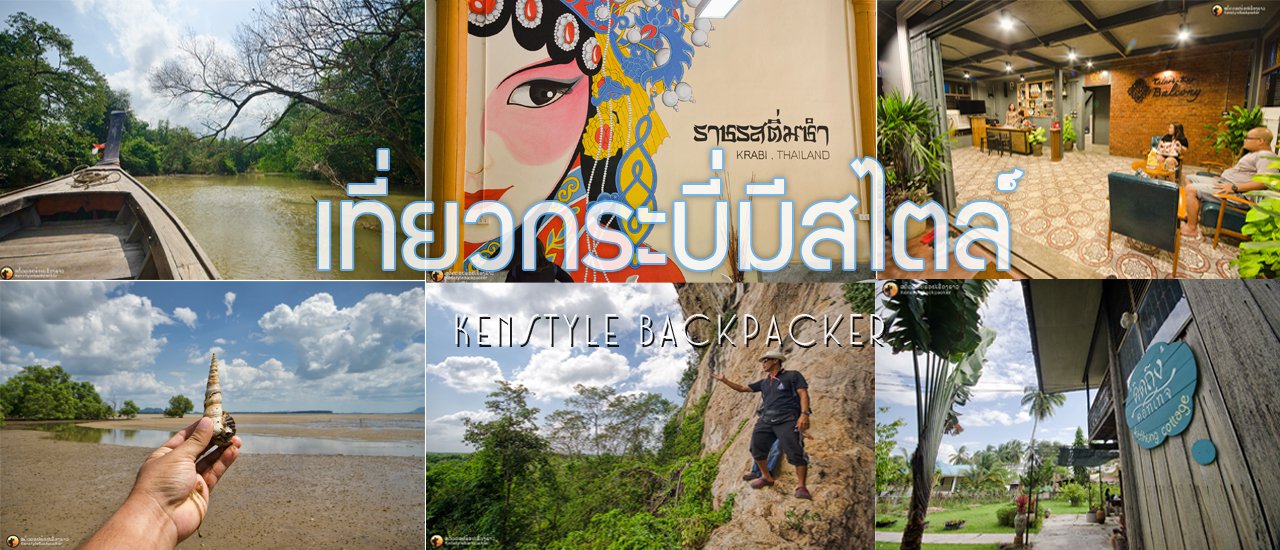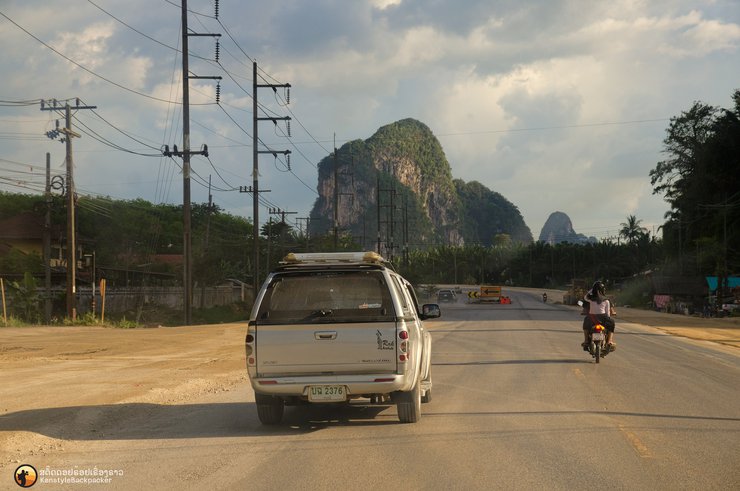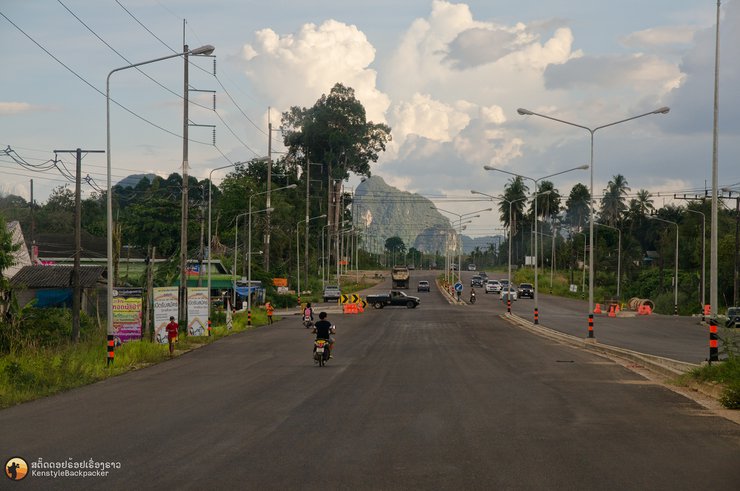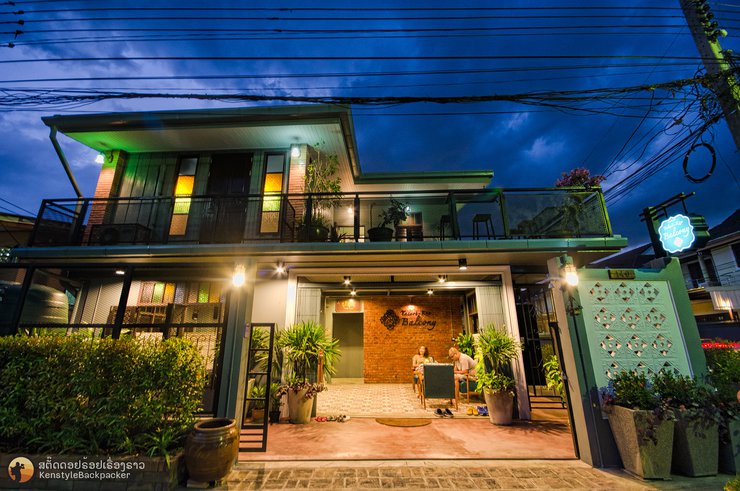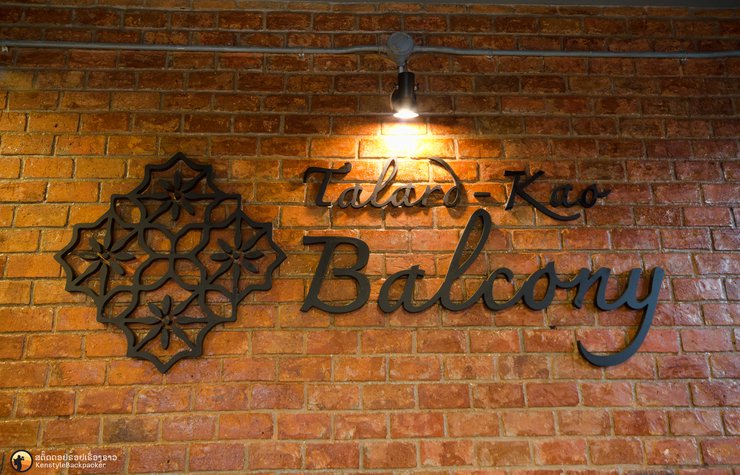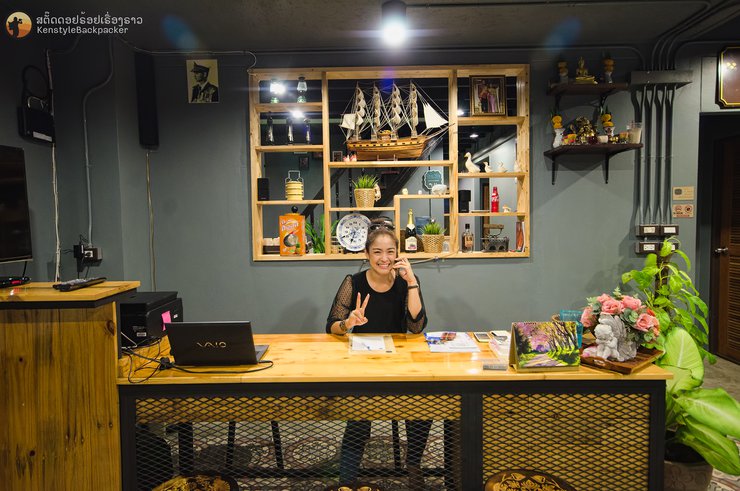
Krabi is a province with numerous enchanting tourist attractions, including white sand beaches, crystal-clear waters, stunning coral reefs, towering limestone cliffs, and hundreds of small islands. Exploring all of these wonders would take days, months, or even years. However, I will take you on a one-day tour that highlights a different aspect of Krabi: Thai traditions. This year, the Tourism Authority of Thailand (TAT) has launched the "Amazing Thai Local Experience" campaign, promoting a new trend in tourism that focuses on experiencing the authentic Thai way of life. This type of tourism not only provides enjoyment but also allows visitors to gain insights into the roots and wisdom of Thai culture. My journey to Krabi began after a three-day, two-night trip to Khao Sok National Park (see my previous review here). I flew from Bangkok to Khao Sok and then continued my journey to Krabi. From Baan Ta Khun in Surat Thani, I took Highway 401 (Surat Thani - Takua Pa) and turned left at the Sam Yaek Ton Yuan intersection onto Highway 415 (Si Yai Na Nuea - Phanom). I continued straight until the Na Nuea intersection, turned left onto Phetkasem Road, and drove straight into Krabi town. At the Muang Kao intersection, I turned left onto Muang Kao Road and continued to my accommodation, "Baan Talat Kao Balcony," located in the Talat Kao community. The total distance was approximately 130 kilometers, and the journey took about two and a half hours.


After a long journey to our accommodation, which took almost 6 pm, we spent our time exploring the lotus flower fields at Khao Sok and sightseeing along the way. As a result, we arrived very late, forcing us to adjust our original 2-day, 1-night itinerary in Krabi to just 24 hours before our flight back. But before we delve into what we managed to see in the limited time we had, let's take a look at our accommodation.
Talardkao Balcony
Located at 140 Muang Kao Road, Klong Krabi Yai Subdistrict, Mueang Krabi District, this old house has been renovated into a small, cozy hostel or boutique house. The atmosphere is relaxed, like staying at a relative's house. The warm lighting of the accommodation contrasts with the twilight sky, creating a sense of warmth and inviting daydreams of the past. This is likely due to the interior design of the accommodation, where the walls and floors are in a loft style that blends seamlessly with vintage-style decorations. These decorations are things I remember from my childhood, such as a sewing machine table adapted into a coffee table paired with an antique coffee shop chair, a vintage-style sofa, lace curtains sewn by the owner's mother, and stained glass windows with a retro floral pattern. The boutique house is managed by the warm and friendly owner, Ms. Aum.
- Location: 140 Muang Kao Road, Klong Krabi Yai Subdistrict, Mueang District, Krabi 81000
- Phone number: 075-644120
- Email: [email protected]
- Facebook: https://www.facebook.com/krabiboutiquehouse
- Coordinates: 8.099035, 98.914254
Getting to Baan Talad Kao Balcony
- From the airport, a car ride costs 300 baht per car.
- From the bus terminal, a shared taxi costs 50-100 baht per person.








The accommodation consists of seven rooms, each named after a family member, reflecting the guesthouse's motto, "Everyone is Family." Prices for the rooms are as follows: * **Grandpa's Room:** A double room on the second floor with a private bathroom and balcony, priced at 1,200 baht per night. * **Grandma's Room:** A double room on the second floor with a shared bathroom, priced at 700 baht per night. * **Father's Room:** A double room on the first floor with a private bathroom, priced at 900 baht per night. * **Mother's Room:** A single room on the second floor with a private bathroom, priced at 600 baht per night. * **Brother's Room:** A four-bed male dormitory on the first floor with a shared bathroom, priced at 300 baht per bed per night. * **Sister's Room:** A four-bed female dormitory on the second floor with a shared bathroom, priced at 300 baht per bed per night. * **Friend's Room:** A four-bed mixed dormitory on the second floor with a shared bathroom, priced at 300 baht per bed per night.
Here are some photos of the rooms. The overall atmosphere of each room is as follows. There is also a shared kitchen, and on the second floor there is a shared balcony where you can relax and enjoy the atmosphere and the way of life in this area. In the morning, there are always cyclists exercising on the road in front of the accommodation. The accommodation also provides bicycles for guests to use.
Common Room





Grandfather's room




Notes:
- The original text is empty, so the translation is also empty.
- I have maintained the HTML structure of the original text.
- I have not added any additional information or interpretation.

Mother's room


Shared bathroom



Second Floor Balcony



After exploring the accommodation and taking a shower, our stomachs began to growl like a storm approaching, as we had used a lot of energy hiking to see the blooming lotus flowers that morning. So, Ms. Oum, the owner of the accommodation, took us to a famous restaurant in Krabi province.
Nong Joke Restaurant
"Nong Joke Restaurant" is a renowned restaurant in Krabi, Thailand, specializing in authentic Southern Thai cuisine. It is a must-visit for those seeking a culinary adventure in the heart of Krabi town. The restaurant offers a diverse menu featuring signature dishes such as: * **Cockle Stir-Fry:** A tantalizing dish featuring fresh cockles stir-fried with aromatic spices and herbs. * **Red Curry with Sea Bass and Coconut Sprouts:** A flavorful red curry with sea bass, coconut sprouts, and a blend of Southern Thai spices. * **Crab Meat Curry with Vermicelli Noodles:** A rich and creamy crab meat curry served with vermicelli noodles, a perfect combination of textures and flavors. * **Stir-Fried Jungle Fern with Egg:** A healthy and delicious dish featuring stir-fried jungle fern with egg, a local delicacy. * **Indonesian Mackerel Fried with Soy Sauce:** A crispy and flavorful Indonesian mackerel fried with soy sauce, a popular choice among seafood lovers. * **Shrimp Paste Chili Dip:** A traditional Southern Thai chili dip made with shrimp paste, a perfect accompaniment to various dishes. Among these delectable offerings, the Red Curry with Sea Bass and Coconut Sprouts stands out as a personal favorite. The curry's bold flavors and the sea bass's delicate texture create an unforgettable culinary experience. **Location:** 50/3 Moo 7, Sai Thai Subdistrict, Mueang Krabi District, Krabi 81000 **Phone Number:** 075 611 639 **Opening Hours:** 11:00 AM - 2:00 PM and 5:00 PM - 9:00 PM **Facebook:** https://www.facebook.com/NongjokeKrabi/ **Coordinates:** 8.050353, 98.916401 Nong Joke Restaurant provides a convenient takeaway option with freeze-packed meals, allowing customers to enjoy the restaurant's signature flavors at home or during travel. The restaurant's commitment to quality and authenticity ensures a memorable dining experience for all who visit.









A wide variety of sweet treats are available to choose from.



Beautifully packaged souvenirs from the shop, frozen without preservatives.


Krabi Walking Street
After a satisfying meal, it's time for a leisurely stroll. But where to go when darkness has fallen? On Saturday nights, the vibrant walking street of Krabi Town beckons. Head to Soi 8 on Maharaj Road, near Vogue Department Store, where the lively market unfolds every Friday, Saturday, and Sunday from 5 pm to 10 pm. Discover a treasure trove of souvenirs, local delicacies, and handcrafted mementos. Indulge in the flavors of the region and shop for unique keepsakes. As night deepens, a string of cozy bars come alive, offering a haven for weary travelers to unwind with soothing music.








Roti with Vocation
The bustling streets of Krabi come alive after dinner, with locals and visitors alike flocking to a renowned roti stall near the Vogue Department Store in Mueang District. Situated close to the "Ancient Human" intersection, this popular eatery draws long queues reminiscent of concertgoers eagerly awaiting their idols. Open daily from 6 pm to 11:30 pm, the stall offers a delectable array of roti, both crispy and soft, with options including egg and banana fillings. Indulge in your preference, whether it be the delightful crunch of a crispy roti drizzled with condensed milk or the comforting softness of a classic roti, all perfectly complemented by a cup of fragrant, soul-soothing tea.




The next morning, we woke up to the fresh morning air and watched people exercising on the path. Some were running, while others were cycling. This road leads to Klong Krabi Yai, a pier where boats depart for the mouth of the Krabi River. We planned to visit after breakfast.




Maharaja Market
This morning, the owner of our accommodation, Mr. and Mrs. Aum's parents, took us for a walk around the Maharaj Market. This market is not only full of fresh and dried ingredients for cooking, but also has a wide variety of delicious-looking food stalls. As we strolled through the market taking photos, the vendors and locals were all smiles, some even greeting us with a friendly smile. Just as we were enjoying ourselves, we came across a stall and were about to raise our camera to take a picture when the vendor asked if we were Thai. When we replied yes, the vendor informed us that Thais must ask permission before taking photos, while foreigners can take photos freely without asking. I was a bit surprised by the vendor's thinking. Taking photos of people in public places like this requires caution, as everyone has different thoughts and feelings. While our intention was to promote tourism, the vendor was probably worried that we would take photos and attack them on social media (that's my guess).






Black Crab Viewing Platform at Khao Khanap Nam
Departing from the market, we drove around the city, stopping to take pictures at the Black Crab Square near the Khao Khanap Nam Pier. Everyone who visits Krabi always stops to take a picture here as a souvenir. In the background, you can see Khao Khanap Nam, the city's landmark, standing in the distance. Observing the lives of the people and the city in the early morning, it was quite peaceful and quiet. It felt like a relaxed life with no rush, and the roads were remarkably clean. It was different from what I expected, thinking that a tourist city would be full of pubs and bars. However, this is not the case here, as the community's identity is well preserved, living up to the province's motto, "Krabi, a livable city with friendly people."





Royal Dignity
After exploring the city in the morning, it's time to grab a bite to eat. When in Krabi, you must try dim sum. This particular dim sum restaurant is said to be one of the top four in the province. Located on Uthakit Road near the Esso gas station, it occupies two large shophouses. The food is delicious, especially the bak kut teh, which is my personal favorite.
- Location: Uthakit Road, Pak Nam Subdistrict, Mueang Krabi District, Krabi 81000, Thailand
- Phone number: 081-9787811
- Opening hours: 06:00-12:00
- Facebook: https://www.facebook.com/ราชรส-ติ่มซำ-จกระบี่
- Coordinates: 8.070660, 98.916361






Stone Table Court
After a satisfying meal, we returned to our accommodation to freshen up before embarking on the next leg of our adventure. This time, we were accompanied by local guides named Ae and Mus, who provided insightful explanations about the various locations we visited. The owner of our accommodation, Uam, and her parents also joined us, adding a touch of warmth and hospitality to our journey. Our first stop was the Klong Hin Khwang pier, located approximately 500 meters from our accommodation. Before boarding the boat, guide Ae led us to pay respects at the Toh Hin Khwang shrine, situated near the bridge crossing the Krabi Yai Canal. The word "toh" in Malay translates to "great-great-grandfather," suggesting that the shrine is dedicated to an ancestor. The name "Hin Khwang" refers to a large rock that obstructs the canal, becoming clearly visible during low tide. This shrine holds significant importance for the province, boasting an age of over 140 years, dating back to the founding of Krabi town. Legend has it that Toh Hin Khwang was a sacred crocodile spirit. One day, a poor fisherman who earned his living by catching fish in the Krabi Yai Canal in front of the shrine wished to marry his beloved but lacked the financial means. He prayed at the shrine, asking for a bountiful catch to enable him to afford the wedding expenses. His plea reached Toh Hin Khwang, the giant crocodile, who, along with his followers, herded a multitude of fish onto the shore. The fisherman was able to sell the abundant catch, amassing a considerable sum. Following this miraculous event, the Toh Hin Khwang shrine became a popular destination for devotees seeking blessings and favors.





Cruising the Krabi Yai Canal
After paying respects at the Hin Khuang stone table, we walked back to the Hin Khuang pier, which was not far away, to take a long-tailed boat along the Krabi Yai Canal to the mouth of the Krabi River. We admired the scenery of the mangrove forests on both sides of the canal and the way of life of the local fishermen who raise crabs, fish, and shellfish in cages in that area. We sat and enjoyed the natural scenery until we reached Khao Khanap Nam, where we stopped to visit the cave on top of the hill.





They flank the water.
Flanked by two mountains, the Krabi River flows through the center, emptying into the Andaman Sea at the mouth of the Krabi River. An entrance fee of 30 baht is charged per person. Evidence suggests that prehistoric humans once inhabited this mountain, as evidenced by the discovery of remnants of tools, cave paintings, and ancient human skeletons during excavations. Today, only cave paintings remain, and the provincial government has erected sculptures depicting the lives of cave dwellers inside.

The cave entrance is like an adventure, a small hole that you have to crawl through.



Whoever emerges here seems to know the area well.

The cave paintings depict scenes from the daily lives of the cave dwellers, with 4-5 distinct locations identified.



If there is enough light, it is because part of the cave ceiling has collapsed into a large cavity. Climbing up to look at the top, the height should be around 4-5 meters. The view from above, when you stand and look out, you won't see much because this side is full of mangrove forests.




The exit from the cave leads to another path, which was actually the original entrance and exit used by the Jackie Chan film crew. The path we entered through was the old path, but the guide pretended to give us a little adventure for fun.

Leaving the limestone mountains, we took a shortcut by boat, navigating through a network of small canals. The dense mangrove tunnels evoked the atmosphere of an Amazonian documentary. We encountered a large anaconda! Well, not quite. It was a cobra residing in the mangroves, but it still sent shivers down our spines, fearing it might slither onto our boat.





Riverside Seafood Restaurant
Another recommended lunch spot after a scenic boat ride. This restaurant is located in Khlong Prasong Subdistrict, Mueang District, but not in the city center. It is situated in the mangrove forest area of Khlong Krabi Yai, in the Muslim community of Ban Ko Klang. This area is home to villagers who raise fish in cages, and they have opened a restaurant. The restaurant is managed by Bang Matt. Phone number: 085-9333971.
- Location: 30/1 Khlong Prasong Subdistrict, Mueang Krabi District 81000
- Phone number: 085-9333-971, 091-328-4549
- Opening hours: 9:00 - 21:00
- Facebook: https://www.facebook.com/KanabnamViewSeafood/
- Website: http://www.kanabnamviewseafood.com/
- Coordinates: 8.056180, 98.932937





Let's take a look at some of the restaurant's recommended dishes. While this is a Muslim-owned establishment, it offers more than just Muslim cuisine. The menu also features seafood and other general dishes. Bang Mas enthusiastically explained each dish as we enjoyed our meal together.








Exploring the Community Way of Life at Koh Klang Village
After a delicious meal, we embarked on a tour of the island, riding in a motorcycle sidecar or a three-wheeled vehicle. We observed the simple lifestyle and culture of the community, which is predominantly Muslim (90%). We also learned about the local wisdom in creating unique community products, such as miniature model boats, batik fabric, tattooing, boat building, and kite making. Unfortunately, we missed the opportunity to see the production of the famous "Khao Sangkhip" rice, as it had already been harvested. Our driver and guide, Bang Lae, provided insightful explanations at each location during our 11 km journey around the island. Before we delve further, let's briefly discuss the tourism practices on Koh Klang.
Guidelines for Tourists
- No drugs or intoxicants of any kind are allowed on the island.
- No food containing pork is allowed on the island.
- No dogs are allowed on the island.
- Dress modestly and conservatively. Women should not wear spaghetti straps, tank tops, or very short shorts.
- Do not engage in public displays of affection or indecency.




- OTOP Center for Building Model Head Boats
Our first stop is the OTOP Center in Ban Ko Klang, a learning center for the construction of simulated Huatong boats, pioneered by Mr. Samboon. Mr. Laeha explained the history and steps involved in building Huatong boats in detail.





Another fascinating aspect is the traditional wisdom of villagers in the past who invented and used lighters made from buffalo horns. They worked by pumping air in and out, creating friction with a piece of wood coated in beeswax as fuel. Pushing the wood in and pulling it out quickly generated enough heat to create sparks and ignite the fire.




- Kite making house
The next point is the kite-making house. Here, kites are flown after the harvest, and there are always competitions. Bangla explained everything from the different types of kites to the rules of the competition, which sounded exciting and fun to watch. They compete for days and nights, even at night, with kites flying until morning. They even need flashlights to see them.



The front of the house overlooks rice fields, which transform into a kite-flying competition ground after the harvest season. Three-wheeled vehicles transport foreign tourists to witness the local way of life. One can only imagine the pleasant atmosphere here during the morning or evening hours. Unfortunately, our limited time did not allow for a longer stay, but we will definitely return for a more thorough visit.



- OTOP Center for Patola Weaving Group
The journey continues to the batik weaving group, a community-based initiative inspired by batik techniques from Pattani province. They have adapted these techniques to create their own unique style, blending batik with traditional fabrics. The intricate patterns and vibrant colors showcase their distinctive artistry. Visitors are welcome to learn and try their hand at batik making, gaining firsthand experience in this cultural tradition.





- Tattooing of the conch shell
Shell picking is the act of digging for shellfish. Villagers dig for shellfish on the beach during low tide. The most common shellfish found on the beaches of Ko Klang are sweet clams, ark clams, cockles, venus clams, thick-lipped clams, blood clams, and pen shells. Each type of shellfish has a different way of being observed and found. For example, some people walk around looking for clam holes, poke them with a stick, dig them up, and pull them out with their feet, then flick them into a can without having to bend down. The clams are then sold or used to cook meals at home. Famous dishes include boiled sweet clams with lemongrass and stir-fried ark clams with coconut milk. In addition, if you check the tides carefully, this location is a great place to take photos during sunset. The beach has a 180-degree angle and a panoramic view of the islands and mountains, such as Ko Kai, Phi Phi Island, Khao Hong Nak, and Khao Phanom Bencha.

** **

****

** **

**Please provide the sentence or phrase you would like me to translate.**


** **


- Houseboat at Huatong Pier
At this point, the guide led us to visit and tell the story of the construction of the "หัวโทง" boat. The budget for building each boat starts from hundreds of thousands of baht, depending on the size of the boat. By looking at the number of "กระดูกงู" (snake bones) of the boat, we can know how many meters the boat is. The bow of the boat, called "หัวโทง", which serves to break the waves, is also a point of reference for navigation. For example, if we want to go to an island, we turn the bow of the boat by using the "หัวโทง" as a compass pointing to the island, so we won't get lost.




On the way back, I stopped to chat with some locals who make a living by shelling horse crabs. They told me that they buy horse crabs, boil them, and then shell them for restaurants. To get one kilogram of crab claws, they have to shell 10 kilograms of crabs. One kilogram of crab claws fetches a good price, so it's a decent income.



We stopped to buy snacks along the way, which were mostly common Thai desserts that we had tried before. Regardless of whether one is Buddhist or Muslim, the desserts are generally similar, although there may be some variations in taste and appearance. For example, the "lod chong" we bought was wrapped in separate banana leaves.


Missing the Cottage
On the way back, the guide Matt took us to his house for a drink. His house is an old 2-story wooden house made into a Halal homestay. The guide told us that he used to live on this island, but he grew up and studied in Bangkok. After graduating, he worked in Bangkok and then moved to Phuket for more than 5 years. Many relatives from Bangkok and Chiang Mai who visited him here were impressed by the atmosphere of the island. There was a time when the house was abandoned for a year, and then a relative from Bangkok came by and said that he was heartbroken and missed the old image he used to see, hence the name "คิดถึง" (Missing). Because it has an atmosphere and stories that he wants to share with others. I believe that anyone who stays here will miss their old home when they were young and used to run and play around the house with nature.
- Location: 162 Moo 1, Koh Klang Village, Khlong Prasong Subdistrict, Mueang District, Krabi Province 81000
- Phone number: 081 494 7470, 084-1421600
- Email: [email protected]
- Facebook: https://www.facebook.com/kidthung.cottage/
- Coordinates: 8.055814, 98.931962
Getting to Kid Tung Cottage and Koh Klang Community
There are three ways to get to the airport.
- Airport bus: 90 baht per person (The bus will take you to a transfer point in the city, where a shared taxi will take you to your final destination. The shared taxi is free of charge, but drivers typically expect a tip. ^_^)
- Taxi fare: 400 baht per ride
- 600 baht per van
From the bus terminal, take a red songthaew (shared taxi) to the city center and get off at Chao Fah Pier. The fare is 15-20 baht per person. (The bus terminal is 5 km from the city center.)
Public Pier at Thara Park
The public pier at Thara Park is located on the mainland side, next to the Sofia Thara restaurant. It serves as a ferry crossing point for residents of the central island. The fare is approximately 10 baht, and the journey takes about 5 minutes. Upon arrival, passengers can take a motorbike taxi from the pier to their accommodation for around 20 baht.
**Chao Fah Pier**, located in the city center opposite the Krabi Customs Checkpoint or near the Black Crab Square, takes approximately 15 minutes to reach **Tha Hin Pier** on the central island or next to Baan Maheying Restaurant (the fare is negotiable with the boat owner). Then walk straight for another 50 meters to reach the homestay (this pier is convenient for those considering the cottage).





Upon entering the house, you will find a cozy reading and relaxation area with plush triangular cushions and thick floor mats. The interior design is minimalist, featuring antique furniture and decor. The open and airy atmosphere creates a sense of tranquility.









The accommodation comprises three rooms: one family room and one room for groups of friends or large families, both located on the second floor. A third room, designed for couples and decorated in yellow tones, is situated on the first floor. The staircase leading to the second floor features a quirky bookshelf.




Our afternoon snack has arrived. It's Thai dessert that we bought on the way. I must say, the "Lod Chong" is delicious! The noodles are thick and chewy, and the coconut milk is perfectly sweet and fragrant. The butterfly pea flower juice with a squeeze of lime is perfect for the afternoon heat. After finishing the snack, we almost wanted to lie down and relax. The side of the house has a dining table, and it feels like this house has relaxing corners everywhere, both inside and outside. Everywhere you walk, there are places to sit and lie down. The only thing missing is a traditional swinging bench. The yard is perfect for activities around the bonfire, I mean, grilling and barbecuing seafood that we caught ourselves. Just thinking about it makes me excited.






The journey has finally reached its final chapter, leaving behind memories that will last a lifetime. The inscription on the guestbook's cover is unforgettable, and the experience continues to linger in my thoughts even after my return. It evoked childhood memories of a home with a similar layout, prompting a promise to myself to return someday.
Thank you to the creators of this wonderful trip for making my travel experience so memorable.
- Khun Aum and her family for their hospitality at Ban Talad Kao Balcony.
- Khun Matt and Khun Mona, the lovely couple of Kit Tueng Cottage.
- Khun Ae, the cheerful local guide throughout the trip.
- Khun Joke of Nong Joke Restaurant.
- Bang Matt of Khanab Nam View Seafood.
- Bang Lae, the community guide of Koh Klang Village.
- Thank you to my friends who have come to watch and like and share. It's encouraging.
- Exchange information or ask questions about travel. Fanpage: Studdoy Hundred Stories
- Follow our previous articles here All travel trips
สตั๊ดดอย ร้อยเรื่องราว
Friday, October 4, 2024 3:22 PM

